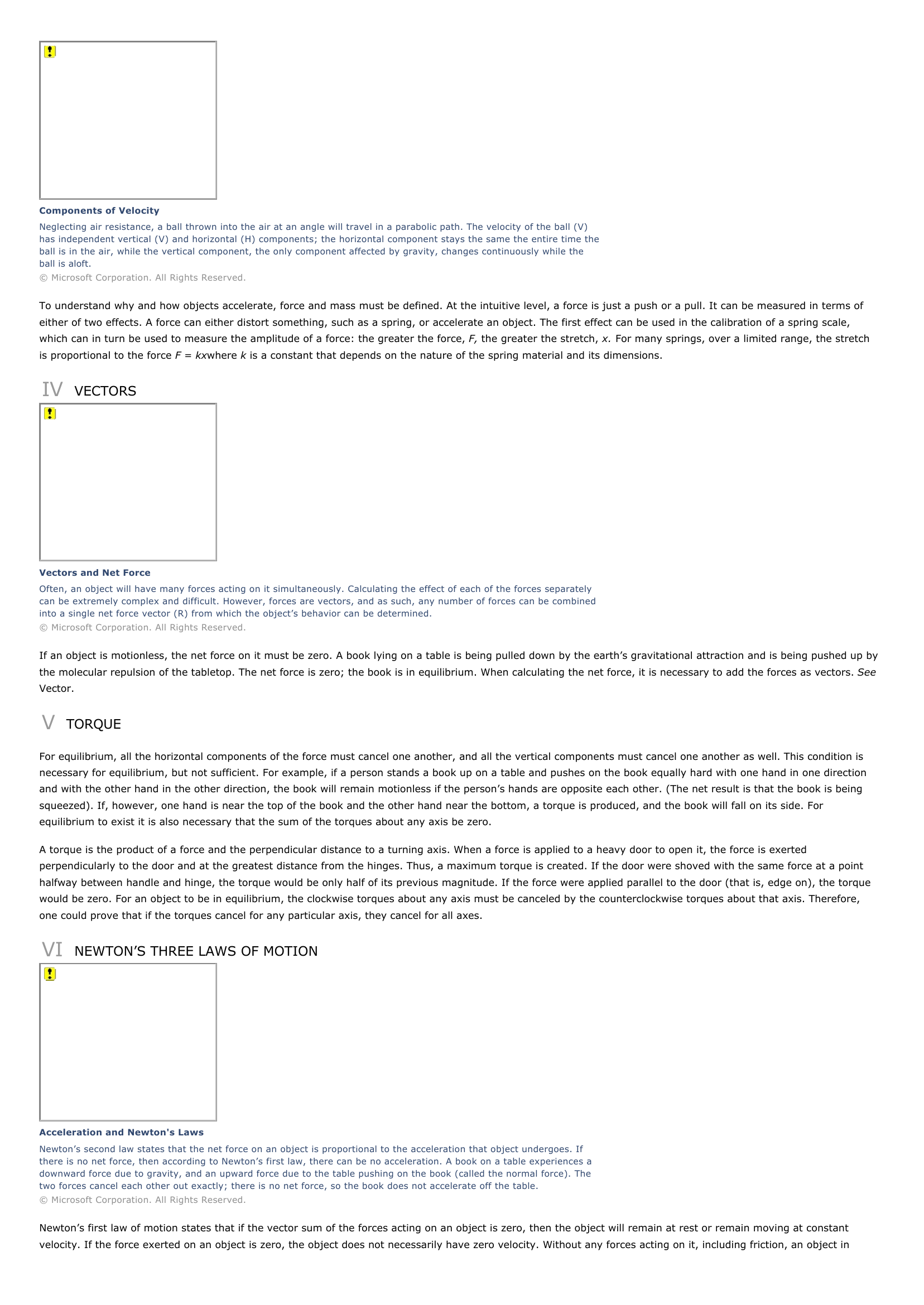Mechanics I INTRODUCTION Mechanics, branch of physics concerning the motions of objects and their response to forces.
Publié le 12/05/2013
Extrait du document
«
Components of VelocityNeglecting air resistance, a ball thrown into the air at an angle will travel in a parabolic path.
The velocity of the ball (V)has independent vertical (V) and horizontal (H) components; the horizontal component stays the same the entire time theball is in the air, while the vertical component, the only component affected by gravity, changes continuously while theball is aloft.© Microsoft Corporation.
All Rights Reserved.
To understand why and how objects accelerate, force and mass must be defined.
At the intuitive level, a force is just a push or a pull.
It can be measured in terms ofeither of two effects.
A force can either distort something, such as a spring, or accelerate an object.
The first effect can be used in the calibration of a spring scale,which can in turn be used to measure the amplitude of a force: the greater the force, F, the greater the stretch, x.
For many springs, over a limited range, the stretch is proportional to the force F = kxwhere k is a constant that depends on the nature of the spring material and its dimensions.
IV VECTORS
Vectors and Net ForceOften, an object will have many forces acting on it simultaneously.
Calculating the effect of each of the forces separatelycan be extremely complex and difficult.
However, forces are vectors, and as such, any number of forces can be combinedinto a single net force vector (R) from which the object’s behavior can be determined.© Microsoft Corporation.
All Rights Reserved.
If an object is motionless, the net force on it must be zero.
A book lying on a table is being pulled down by the earth’s gravitational attraction and is being pushed up bythe molecular repulsion of the tabletop.
The net force is zero; the book is in equilibrium.
When calculating the net force, it is necessary to add the forces as vectors.
See Vector.
V TORQUE
For equilibrium, all the horizontal components of the force must cancel one another, and all the vertical components must cancel one another as well.
This condition isnecessary for equilibrium, but not sufficient.
For example, if a person stands a book up on a table and pushes on the book equally hard with one hand in one directionand with the other hand in the other direction, the book will remain motionless if the person’s hands are opposite each other.
(The net result is that the book is beingsqueezed).
If, however, one hand is near the top of the book and the other hand near the bottom, a torque is produced, and the book will fall on its side.
Forequilibrium to exist it is also necessary that the sum of the torques about any axis be zero.
A torque is the product of a force and the perpendicular distance to a turning axis.
When a force is applied to a heavy door to open it, the force is exertedperpendicularly to the door and at the greatest distance from the hinges.
Thus, a maximum torque is created.
If the door were shoved with the same force at a pointhalfway between handle and hinge, the torque would be only half of its previous magnitude.
If the force were applied parallel to the door (that is, edge on), the torquewould be zero.
For an object to be in equilibrium, the clockwise torques about any axis must be canceled by the counterclockwise torques about that axis.
Therefore,one could prove that if the torques cancel for any particular axis, they cancel for all axes.
VI NEWTON’S THREE LAWS OF MOTION
Acceleration and Newton's LawsNewton’s second law states that the net force on an object is proportional to the acceleration that object undergoes.
Ifthere is no net force, then according to Newton’s first law, there can be no acceleration.
A book on a table experiences adownward force due to gravity, and an upward force due to the table pushing on the book (called the normal force).
Thetwo forces cancel each other out exactly; there is no net force, so the book does not accelerate off the table.© Microsoft Corporation.
All Rights Reserved.
Newton’s first law of motion states that if the vector sum of the forces acting on an object is zero, then the object will remain at rest or remain moving at constantvelocity.
If the force exerted on an object is zero, the object does not necessarily have zero velocity.
Without any forces acting on it, including friction, an object in.
»
↓↓↓ APERÇU DU DOCUMENT ↓↓↓
Liens utiles
- Physics I INTRODUCTION Physics, major science, dealing with the fundamental constituents of the universe, the forces they exert on one another, and the results produced by these forces.
- Steven Spielberg I INTRODUCTION Steven Spielberg The imaginative films of Steven Spielberg are known for their technical creativity and memorable characters.
- Metalwork I INTRODUCTION Metalwork, in the fine arts, objects of artistic, decorative, and utilitarian value made of one or more kinds of metal--from precious to base--fashioned by either casting, hammering, or joining or a combination of these techniques.
- Native American Art I INTRODUCTION Native American Art, the visual works crafted by indigenous people of North America, starting after their arrival on the continent thousands of years ago and continuing until the present.
- Thermodynamics I INTRODUCTION Thermodynamics, field of physics that describes and correlates the physical properties of macroscopic systems of matter and energy.


